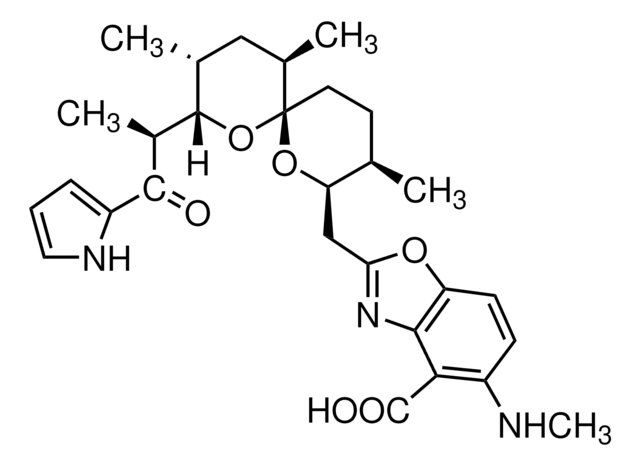Key Documents
M5571
Miltefosine
≥98% (perchloric acid titration)
Synonim(y):
Choline hexadecyl phosphate, HePC, Hexadecyl phosphocholine
About This Item
Polecane produkty
pochodzenie biologiczne
synthetic (organic)
opis
zwitterionic
Próba
≥98% (perchloric acid titration)
Postać
powder
rozpuszczalność
H2O: 10 mg/mL, clear, colorless
grupa funkcyjna
phospholipid
typ lipidu
phospholipids
temp. przechowywania
room temp
ciąg SMILES
[O-]P(OCC[N+](C)(C)C)(OCCCCCCCCCCCCCCCC)=O
InChI
1S/C21H46NO4P/c1-5-6-7-8-9-10-11-12-13-14-15-16-17-18-20-25-27(23,24)26-21-19-22(2,3)4/h5-21H2,1-4H3
Klucz InChI
PQLXHQMOHUQAKB-UHFFFAOYSA-N
Szukasz podobnych produktów? Odwiedź Przewodnik dotyczący porównywania produktów
Zastosowanie
- Easy one-pot synthesis of multifunctionalized indole-pyrrole hybrids as a new class of antileishmanial agents.: This study underlines the necessity for innovative treatments amidst growing resistance to established drugs such as miltefosine which is used as a positive control reference, potentially setting a new direction for antileishmanial drug development (Ciccone et al., 2024).
Działania biochem./fizjol.
Hasło ostrzegawcze
Danger
Zwroty wskazujące rodzaj zagrożenia
Zwroty wskazujące środki ostrożności
Klasyfikacja zagrożeń
Acute Tox. 3 Oral
Kod klasy składowania
6.1C - Combustible acute toxic Cat.3 / toxic compounds or compounds which causing chronic effects
Klasa zagrożenia wodnego (WGK)
WGK 3
Środki ochrony indywidualnej
dust mask type N95 (US), Eyeshields, Faceshields, Gloves
Certyfikaty analizy (CoA)
Poszukaj Certyfikaty analizy (CoA), wpisując numer partii/serii produktów. Numery serii i partii można znaleźć na etykiecie produktu po słowach „seria” lub „partia”.
Masz już ten produkt?
Dokumenty związane z niedawno zakupionymi produktami zostały zamieszczone w Bibliotece dokumentów.
Klienci oglądali również te produkty
Nasz zespół naukowców ma doświadczenie we wszystkich obszarach badań, w tym w naukach przyrodniczych, materiałoznawstwie, syntezie chemicznej, chromatografii, analityce i wielu innych dziedzinach.
Skontaktuj się z zespołem ds. pomocy technicznej









